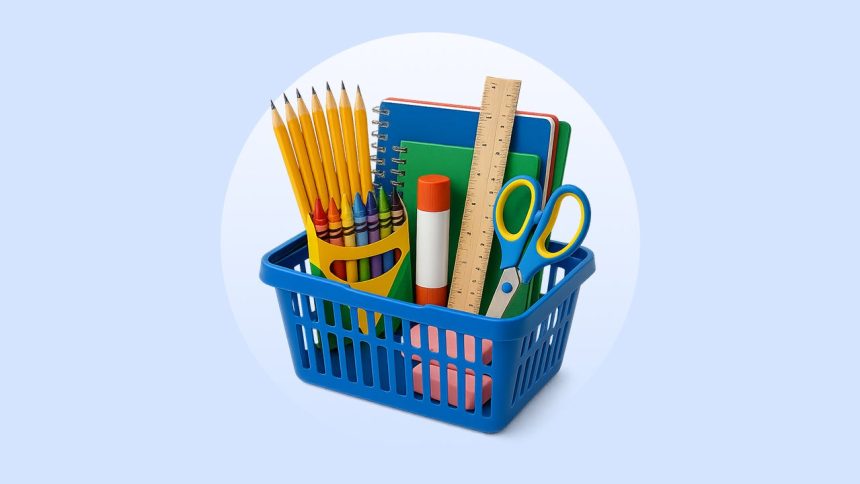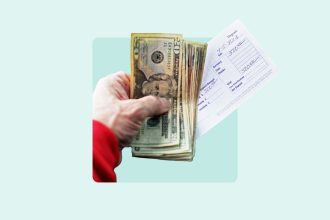Back-to-school shoppers are feeling better, but still not great, about what has become the second-biggest event on the annual retail calendar. This year, 30 percent of back-to-school shoppers say inflation is changing the way they shop, according to Bankrate’s 2025 Back-to-School Survey. On the positive side, that figure is down from 41 percent in 2022, when inflation peaked, and even from 32 percent in 2024. Still, that’s a lot of people who continue to change their habits because of inflation.
The National Retail Federation says the average kindergarten through 12th grade shopper will spend $858 this back-to-school season, down slightly from last year’s record $875. That figure includes school supplies, clothing, shoes and electronics. While the burden isn’t quite as hefty as it was last year, overall, prices have risen a cumulative 24 percent since Feb. 2020, a Bankate analysis of Bureau of Labor Statistics data revealed.
Our back-to-school survey reports that about half (49 percent) of back-to-school shoppers are employing one or more money-saving strategies this year, led by buying cheaper brands than usual (20 percent) and seeking more deals/coupons than in the past (also 20 percent).
Have a question about credit cards? E-mail me at [email protected] and I’d be happy to help.
What this tells us about the economy
Let’s start with the good news: Tariffs haven’t affected back-to-school shopping nearly as much as many feared they would. Shelves are stocked and prices are stable. Prices are actually down (slightly) year-over-year for back-to-school staples such as clothing and computers, according to the latest Consumer Price Index. This helps explain the NRF’s finding that back-to-school shopping is taking a somewhat smaller bite out of consumers’ wallets this summer.
But it’s still a pricey season, of course. Back-to-school season is the second-biggest retail event of the year, behind the winter holiday season. And families have tons of other expenses, including summer camps and vacations on top of the usual basics.
Like the holiday season, the back-to-school shopping season has lengthened in recent years. The NRF found that a record two-thirds of back-to-school shoppers began making these purchases by early July. That early start is a smart move for cost-conscious families as it gives them the ability to spread the impact over multiple paychecks.
Hard data — as in, actual results on consumer spending, economic growth and unemployment — continues to diverge somewhat from soft data — that is, consumer sentiment readings. Even though sentiment has improved a bit over the past few months, according to the University of Michigan’s popular Index of Consumer Sentiment, and wage growth has consistently outpaced inflation since early 2023, I’d still say that the consumer mood remains gloomy. That, though, contrasts with how people are actually shopping this season. The 30 percent of back-to-school shoppers making changes due to inflation is an 11-point improvement from three years ago when inflation peaked.
As JPMorganChase Chief Financial Officer Jeremy Barnum said during the company’s recent earnings call, “In a world with a 4.1 percent unemployment rate, it’s just going to be hard, especially in our portfolio, to see a lot of weakness.”
Consumers still aren’t feeling great, but they’re spending on necessities as well as extras. Demand for discretionary experiences such as travel and dining out has been surprisingly resilient. While back-to-school shoppers are still feeling somewhat frugal, they’re not as burdened as they were a few years ago. Only 20 percent say these expenses are straining their budgets (down from 31 percent in 2022).
Ways to save
I’m always a fan of saving money when I can, and back-to-school spending is no exception. You can bargain hunt, budget, coupon clip and more to help lessen the impact of back-to-school shopping. Here are some ways my family saves.
Stack discounts
My favorite way to save on retail purchases is stacking discounts by combining multiple savings opportunities on the same transaction. For example, start with a rewards credit card and also take advantage of store promotions, card-linked offers and online shopping portals. It’s easy to combine two, three or perhaps even all four of these strategies.
For instance, let’s say you’re buying $100 worth of back-to-school clothes at Macy’s. Here’s how I would combine discounts and my rewards card for maximum impact:
| Savings Method | Description | Savings Amount | New Subtotal |
|---|---|---|---|
| Store Sale or Coupon | 20% off via sale or coupon | -$20.00 | $80.00 |
| Card-Linked Offer (examples include Amex Offers and Chase Offers) | I currently have a Chase Offer for 10 percent cash back at Macy’s (up to $16 in rewards) | -$8.00 | $72.00 |
| Shopping Portal / Cashback App (examples include Rakutan and Capital One Shopping) | I see 4% cash back at Macy’s through Rakutan | -$3.20 | $68.80 |
| Rewards Credit Card | 1% cash back from Chase Freedom Flex® card | -$0.80 | $68.00 |
In total, this $100 worth of goods would only cost my family $68 after combining all four savings approaches. That’s a 32 percent discount. Not bad for a few minutes’ worth of work to research and apply the deals. Plus, you can take the step to make a plan for maximizing your credit card rewards; you might be able to use a cash back card with even higher rewards rates.
Time your purchases well
Another stackable idea is to shop during a sales tax-free weekend or holiday. Many states hold these events in the weeks leading up to the first day of school. The Federation of Tax Administrators publishes a list of tax-free holidays nationwide.
Find teachable moments
I’m also a big fan of involving your kids in back-to-school shopping. Whether they’re in elementary, middle or high school, this exercise presents openings for age-appropriate lessons to become a savvier shopper. Consider sharing the budget with them to work on comparison shopping and emphasize the idea of making trade-offs.
Let’s say they have their heart set on an expensive backpack. If they’re willing to cut back on how much they spend on shoes or school supplies, then that might be OK. Or if they crave the expensive folders or notebooks with their favorite movie characters, they might need to spend a little less elsewhere.
Don’t spend money unless you have to
My wife is good at saving money by taking advantage of a local “buy nothing” group on Facebook. She and other parents enjoy passing along gently-used clothes, toys, school supplies, furnishings and more. It’s free, and it’s good for the environment. There are tons of thrift shops and online marketplaces that facilitate these sorts of swaps.
Shop your own closets and cabinets, too. Maybe you have leftover school supplies from last year that are still perfectly usable. Or a pile of fall and winter clothes that got stashed away over the summer but can be worn again this school year. Before you buy anything new, see if you already have something similar lying around.
Finally, if your student has a long supply list, ask their teacher what’s really needed on day one, versus what can wait until later in the school year. Delaying non-urgent purchases allows you to smooth out your cash flow and even allow you to perhaps take advantage of markdowns on school supplies that often happen after Labor Day.
The bottom line
Consumers seem to be in a better financial mindset going into this busy back-to-school shopping season than they have been in recent years. Still, nearly one-third already have or plan to make changes in how they shop because of inflation. That behavior seems to align with the overall still gloomy consumer sentiment, but it’s also just smart financially.
Back-to-school shopping can be expensive, but it doesn’t need to bust your budget. By stacking discounts, repurposing used goods and spreading out your expenses, you can limit the damage to your bank account. And maybe even teach your kids valuable financial lessons in the process.
Why we ask for feedback
Your feedback helps us improve our content and services. It takes less than a minute to
complete.
Your responses are anonymous and will only be used for improving our website.
Help us improve our content
Read the full article here














